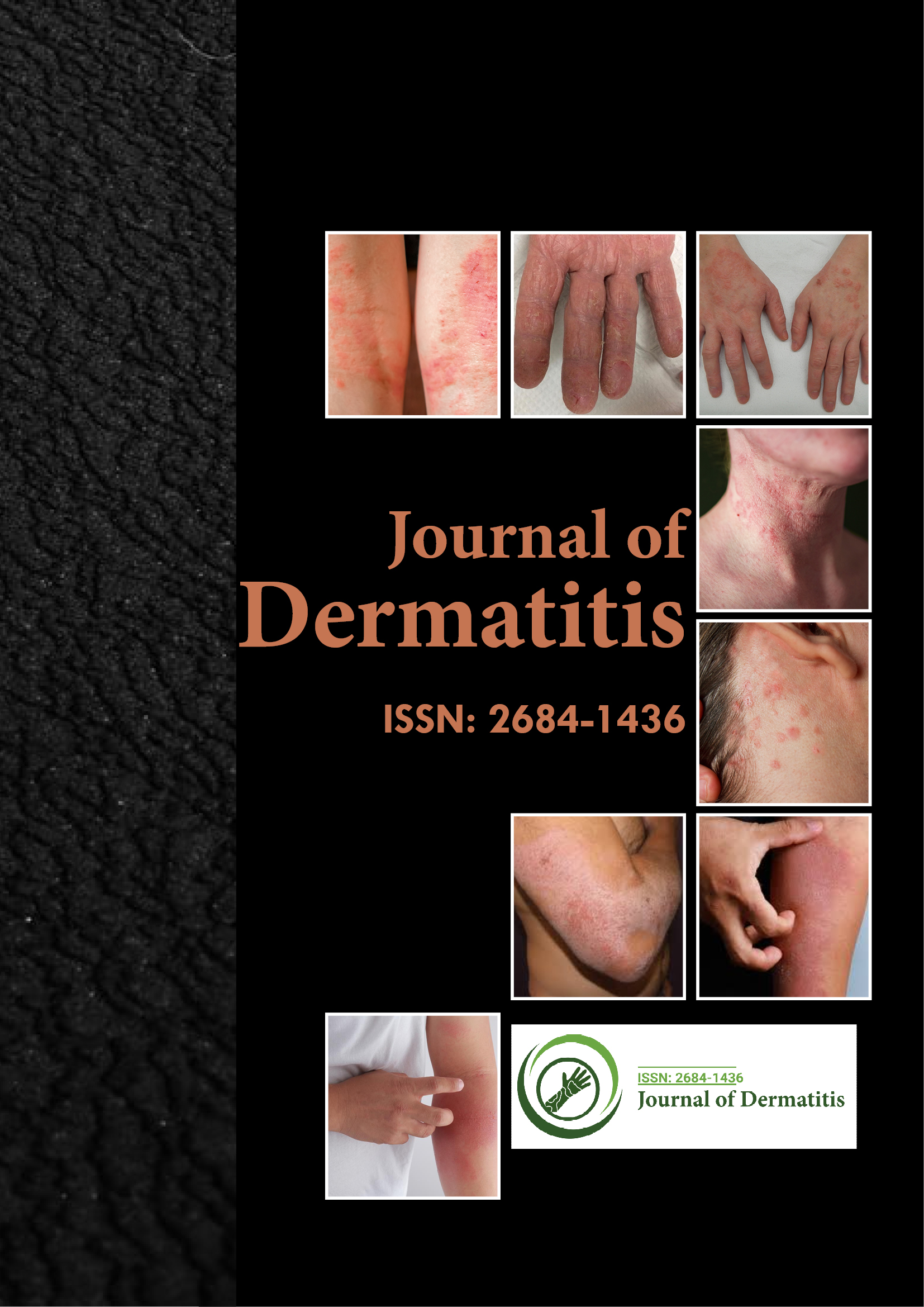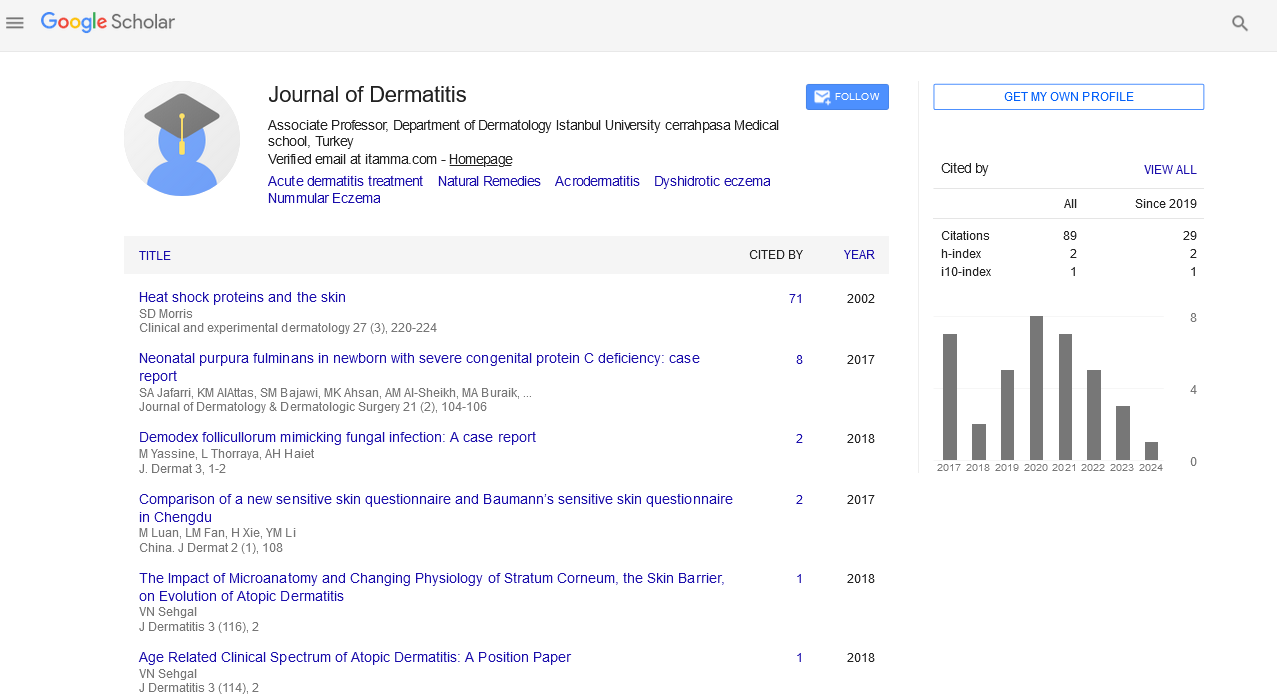Indexed In
- RefSeek
- Hamdard University
- EBSCO A-Z
- Euro Pub
- Google Scholar
Useful Links
Share This Page
Journal Flyer

Open Access Journals
- Agri and Aquaculture
- Biochemistry
- Bioinformatics & Systems Biology
- Business & Management
- Chemistry
- Clinical Sciences
- Engineering
- Food & Nutrition
- General Science
- Genetics & Molecular Biology
- Immunology & Microbiology
- Medical Sciences
- Neuroscience & Psychology
- Nursing & Health Care
- Pharmaceutical Sciences
Opinion Article - (2024) Volume 9, Issue 3
Impact of Benralizumab on Skin Inflammation in Allergic Responses
Michael Brown*Received: 30-Aug-2024, Manuscript No. JOD-24-27945; Editor assigned: 02-Sep-2024, Pre QC No. JOD-24-27945 (PQ); Reviewed: 16-Sep-2024, QC No. JOD-24-27945; Revised: 23-Sep-2024, Manuscript No. JOD-24-27945 (R); Published: 30-Sep-2024, DOI: 10.35248/2684-1436.24.9.243
Description
Skin allergies, initiated by the exposure to specific allergens, can lead to a series of inflammatory events that result in conditions such as contact dermatitis, allergic rhinitis and other hypersensitivity responses. These conditions are frequently characterized by redness, swelling, itching and in some cases, more severe reactions, making management challenging. Traditional therapies for allergic skin reactions primarily focus on anti-inflammatory medications or immunosuppressive agents. However, the rise of biologic therapies, particularly those targeting specific immune cell populations, provides a more targeted approach to managing skin inflammation. One such biologic agent is benralizumab, a monoclonal antibody that targets and depletes eosinophils, which play a major role in allergic inflammatory responses. This opinion article explains the potential impact of benralizumab in reducing inflammation in skin after intradermal allergen challenge, a model commonly used to study allergic responses in humans.
In allergic reactions, eosinophils are central to the inflammatory response. These cells, part of the innate immune system, are activated during allergic reactions and contribute to the release of pro-inflammatory cytokines, chemokines and toxic granules that intensify tissue damage. They also play a role in the recruitment of other immune cells, such as T lymphocytes and mast cells, amplifying the inflammatory response. In the context of skin allergies, eosinophils contribute significantly to the pathology observed after allergen exposure, which is why their depletion could potentially reduce the severity of allergic skin inflammation.
Benralizumab works by selectively targeting the Interleukin-5 (IL-5) receptor alpha subunit on eosinophils, leading to their depletion via antibody-dependent cellular cytotoxicity. This mechanism is especially important in allergic conditions where eosinophils are persistently elevated and contribute to chronic inflammation. By reducing the number of eosinophils, benralizumab may help lessen the inflammatory response caused by skin allergen exposure, potentially reducing the symptoms of allergic skin reactions.
Recent studies have shown that eosinophils contribute not only to the immediate inflammation following allergen exposure but also to the tissue remodeling and chronicity of allergic skin diseases. In patients with chronic allergic conditions, persistent eosinophilic inflammation can lead to more severe symptoms and long-term damage to the skin. By targeting eosinophils, benralizumab may reduce both the acute and chronic aspects of the inflammatory response, preventing the prolonged tissue damage associated with repeated allergic exposures.
In addition to the direct effects on eosinophils, benralizumab may indirectly impact other components of the immune response. For example, the reduction in eosinophils could lead to a decrease in the activation of mast cells and T-helper cells, which are also critical players in allergic skin reactions. Mast cells, when activated, release a variety of mediators such as histamine and cytokines that exacerbate inflammation and cause symptoms like itching and redness. Similarly, T-helper cells, especially Th2 cells, are involved in the promotion of allergic inflammation. By modulating the overall immune environment, benralizumab could potentially lead to a more balanced immune response, reducing the overall allergic burden on the skin.
While the benefits of benralizumab in allergic skin reactions are promising, its use must be carefully evaluated, particularly in the context of long-term treatment. Eosinophils play a role in tissue repair and defense against certain infections, so their depletion could have unintended consequences. For example, a reduction in eosinophil numbers might impair the skin’s ability to recover from tissue damage or protect against certain pathogens. Moreover, the risk of infections and potential long-term effects of chronic eosinophil depletion need to be carefully monitored.
One of the most compelling aspects of benralizumab’s potential use in skin allergen challenges is its ability to target specific immune cells without broadly inhibiting the entire immune system. Traditional therapies that suppress the immune system, such as corticosteroids, can lead to a range of side effects, including increased susceptibility to infections, thinning of the skin and delayed wound healing. In contrast, biologic therapies like benralizumab provide a more targeted approach, which may provide effective relief from allergic inflammation while minimizing systemic side effects.
In conclusion, benralizumab holds promise as a targeted therapy for reducing inflammation in skin following intradermal allergen challenge, particularly in conditions where eosinophilic inflammation plays a central role. By depleting eosinophils and reducing the allergic inflammatory response, benralizumab could provide relief for individuals with allergic skin conditions that are difficult to manage with conventional treatments. However, further studies are needed to fully evaluate its efficacy, safety and long-term impact on skin health, as well as to determine the optimal patient population for this treatment approach. With ongoing research and clinical trials, benralizumab could emerge as a valuable tool in the management of allergic skin inflammation, potentially improving outcomes for patients with allergy-driven skin disorders.
Citation: Brown M (2024). Impact of Benralizumab on Skin Inflammation in Allergic Responses. J Dermatitis. 9:243.
Copyright: © 2024 Brown M. This is an open access article distributed under the terms of the Creative Commons Attribution License, which permits unrestricted use, distribution, and reproduction in any medium, provided the original author and source are credited.

